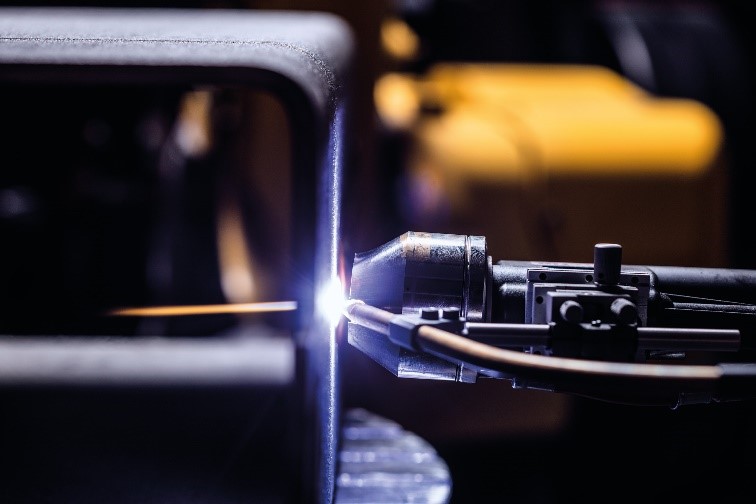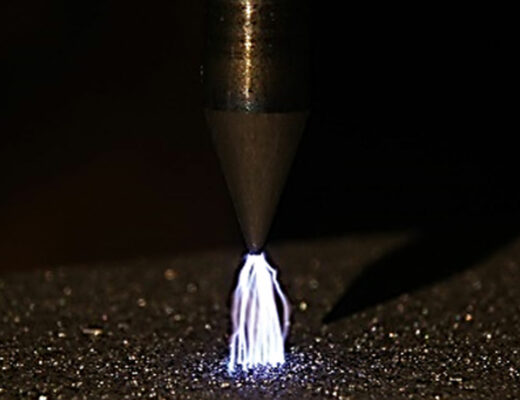From the food industry through to the aerospace sector, wherever top-quality even weld seams are required, many companies rely on TIG welding. This process could be compared with a premium limousine: high class but lacking somewhat in terms of speed. And this precise problem can also quickly become a problem in production processes that use TIG welding technology: the TIG process can be inefficient due to its low speed, particularly for thicker materials that require multiple passes.
But there is help in the form of single-pass keyhole welding, which enables both perfect weld seams and high welding speeds.
What is keyhole welding?
The keyhole welding principle is based on an arc with particularly high energy density. It differs from TIG welding in that the arc energy is focused on a small as opposed to a large area, which results in deep and narrow penetration.
Keyhole welding requires metals with poor thermal conductivity
If the parent material has poor thermal conductivity, this results in heat accumulation in a concentrated area, which is a prerequisite for the keyhole method. Typical materials used are high-alloy or Duplex steels. In contrast to this, the better the thermal conductivity, the less suitable it is for keyhole welding.
If you want to join alloyed steels using keyhole welding, you must bear in mind that the various alloys behave entirely differently to pure metals in terms of their thermal conductivity. For example, nickel has good thermal conductivity. However, when used in a nickel-based alloy, it has poor heat conductivity and is therefore ideally suited to keyhole welding.
Examples of weld properties in relation to thermal conductivity
Poor thermal conductors Good keyhole welding properties / Titanium / Duplex / Nickel-based alloys / Cr-Ni steels
Good thermal conductors Poor keyhole welding properties / Copper / Aluminum / Nickel
Joint preparation for keyhole welding
For good root formation, the arc must burn freely on the underside of the material. A minimum clearance of 8 x 8 millimeters is recommended here.
Ausreichend Freiraum für Formier-Gas und Lichtbogen
Zu wenig Freiraum.
Die Vorrichtung erhitzt und
verursacht Parameteränderungen.
Der Lichtbogen wird abgelenkt.
Es besteht die Gefahr von Porenbildung.
PLASMA KEYHOLE WELDING
Plasma keyhole welding is often found in tank and pipeline construction, as well as in chemical and stainless steel equipment construction. One typical application is square butt welding of longitudinal and circumferential welds on thick-walled pipes, tanks and floors.
Square butt joint
The material thicknesses here range between three and ten millimeters. For wall thicknesses above 10 millimeters, plasma keyhole welding is primarily used for root welding.
Image title: Plasma longitudinal welding with a seam welder
Plasma circumferential welding with carrier gas device
Function and advantages of plasma weldig
In welding technology, plasma welding is a process whereby the arc is constricted by plasma gas. This creates a concentrated, almost cylindrical arc, which changes according to the plasma nozzle diameter and the amount of plasma gas used. The plasma jet itself consists of an accelerated, ionized gas jet and is passed through a special plasma nozzle.
TIG arc (temperatures up to 15000°C) vs PLASMA arc (temperatures up to 30000°C):
The high pressure of the plasma forms what is known as a keyhole at the start of the seam, whereby the parent material is melted through its entire depth. This makes it possible to weld high-alloy chrome-nickel materials with wall thicknesses of up to 10 mm using square butt joints. A cold wire is generally used to fill up the keyhole and counteract root sag. Single-pass welding without pre-processing is possible up to a material thickness of eight millimeters.
Plasma keyhole process:
Plasma keyhole process
In comparison to TIG welding, plasma keyhole welding offers considerable quality and cost benefits as well as unrivaled speed:
- Avoid time-consuming seam preparation work (pre-processing and chamfering of workpiece edges)
- Reduced consumption of additional wire due to smaller filling volumes (square butt joint instead of Y or U butt joint)
Square butt joint
U butt joint
Y butt joint
- Less component distortion due to reduced energy input
- Lower component distortion and low weld reinforcement minimize reworking
TIG KEYHOLE WELDING
Various TIG-based keyhole welding process have been introduced to the market over time by different companies. Most of them were specially developed for mechanized joint welding. In precisely the same way as plasma keyhole welding, TIG keyhole welding is often used where there are similarly high standards in terms of seam quality and cost-effectiveness.
However, TIG keyhole welding is not as well suited for joining surfaced materials, such as galvanized sheet metal. Plasma keyhole welding is particularly suitable here as the plasma nozzle protects the electrode and enables a longer service life.
TIG keyhole welding at Fronius—ArcTig
Fronius’ TIG-based keyhole welding process is known as “ArcTig”. The essential differences between this and the plasma keyhole welding process are as follows: instead of using plasma gas, the ArcTig technology uses wide-area high-performance cooling to concentrate the arc. This has enabled Fronius to lower the temperatures at the tungsten electrode up to the needle tip. This results in a highly concentrated and therefore effective arc. The energy density is high here too and the process is also used for single-pass welding. What’s more, no pre-processing is required and the process can be used to work on materials up to a sheet thickness of ten millimeters.
The use of ArcTig is also beneficial for many other materials. This is because there are fewer parameters to consider due to the lack of plasma power source and plasma gas. This makes welding easier and saves time. And since neither a plasma power source nor plasma gas are required, this results in considerable cost savings.
Weiteres findet sich im Blog-Artikel: ArcTig: Schneller und schöner schweißen
Video ArcTig: Keyhole welding in pipeline construction:
Video ArcTig: Keyhole welding in container construction:
 Perfect Welding Blog
Perfect Welding Blog




8 Comments
Justin Blakes
18. December 2020 at 21:56It is awesome to get to know about all the basics of keyhole welding. Being a novice in this field I am highly thankful.
redakteur
21. December 2020 at 6:30Thank you very much for your feedback!
Terence
23. December 2020 at 8:50Insiteful article. I am using Plasma keyhole and TIG as a joining process on a tube mill.
redakteur
8. January 2021 at 10:16Hello Terence,
thank you for your positive feedback. We are always very happy when we can impart welding knowledge!
If you’re ever thinking about – or interested in – automated Joining technologie in this area, I’d recommend you look into Fronius ArcTig. In my eyes, this is a really fascinating welding process …
Happy New Year to you! 🙂
Paul Southworth
9. February 2021 at 2:15Struggling getting 10mm stainless plasma keyhole through x ray. Lack of fusion gas pores and lack of pen. Would prepping the 10mm to leave a 6mm root face help? Have no problems welding 6mm. Thankyou.
redakteur
12. February 2021 at 10:00Hello Paul,
thank you for your interest and feedback! In general, with a material thickness of 10mm (CrNi) we are at the limit of what is possible with a keyhole process. Many small factors such as gap, offset, material, cut edge etc. play a major role.
The closer you get to the process limit, the more precisely the tolerances must be adhered to – which also makes reproducibility rather difficult.
Tolerances: gap/offset: ~ +/- 10% of material thickness
With a U or Y processing, however, you can counteract this very well and the process is more reliable.
Fronius therefore recommends processing from a material thickness of 8 millimeters.
Advantage: lack of fusion, gas pores, lack of pen are minimized and eliminated.
Disadvantage: a cap layer is necessary to fill the weld – this eliminates problems with possible undercuts on the weld surface.
However, all of this cannot be generalized as it makes a big difference whether it is a pipe application or a longitudinal seam application. Pipe applications are much more sensitive than a longitudinal seam, in the best case it is welded in a clamping bench.
If you need further information please let us know! Thank you!
Alekh Shah
24. June 2021 at 6:21I want to use this application for the welding of the Root welding of the SS/Inconel Cladded plate. Need your guidance on it, and want to know availability power-source in India.
redakteur
24. June 2021 at 13:43Hello and thank you very much for your comment! Can you please send an email to: sales.india[AT]fronius.com – our Fronius team will help you as best as they can. Thank you very much!